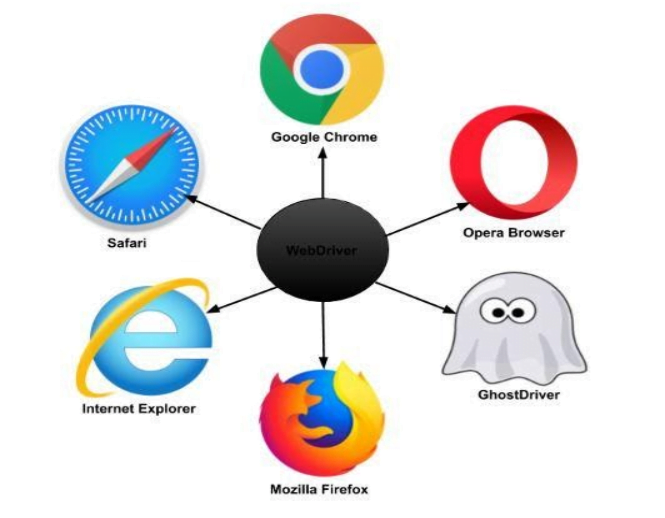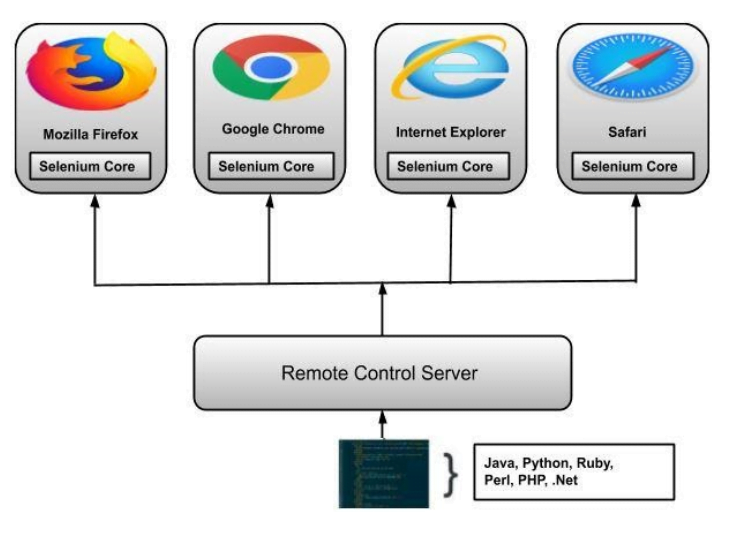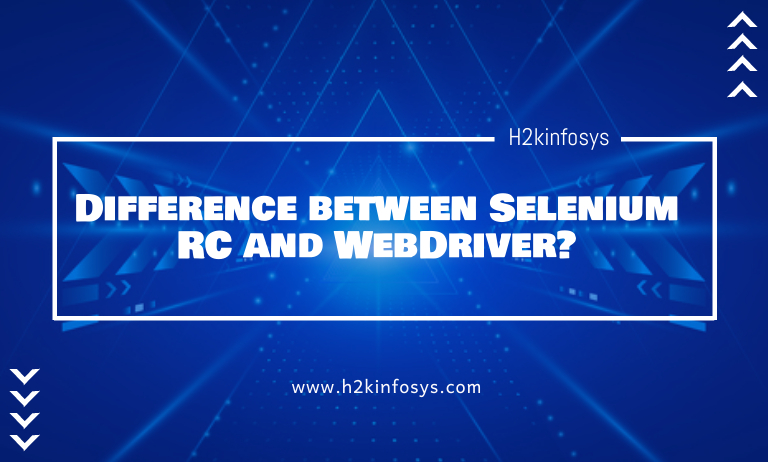What is Selenium WebDriver?
WebDriver is developed to overcome the limitations in the Selenium-RC API. Selenium WebDriver is a cross-platform testing framework that allows you to execute your tests against different browsers like Mozilla Firefox, Google Chrome, InternetExplorer, Safari, Opera, GhostDriver, etc. It is a programming interface to create and run test cases.
It does not require a core engine like Selenium RC and interacts natively with the browser applications. Selenium WebDriver speaks directly to the browser using browser drivers for a particular browser.
Enrolling in a Selenium WebDriver course can help you gain essential skills to utilize WebDriver effectively, covering everything from browser setup to advanced test creation and cross-browser compatibility testing.

Selenium WebDriver supports the following languages
- Java
- Python
- C#
- Ruby
- Perl
- PHP
Difference between Selenium RC and WebDriver
Selenium RC | Selenium WebDriver |
Selenium RC is a Weak API | WebDriver is a Strong API |
Management of excessive test suites is a problem | Management of excessive test suites is a cakewalk |
No support for third-party API and software | Supports third party API and Software |
Need to start RC Server | No need to start any server |
Uses command line prompt | No usage of command-line prompt |
Bad report generation | Can generate the technical and managerial report |
Cannot run Selenium WebDriver script | Can run Selenium RC scripts |
Misfires RC server most of the times | No server, no miss-firing |
Command specific usage | No command used |
Let us discuss how Selenium RC and WebDriver differ each other
Architecture
Selenium WebDriver’s architecture is simple than Selenium RC’s.
- It controls the browser from Operating System-level
- All you need are your programming languages IDE and a browser
Selenium RC’s architecture is more complicated than WebDriver
- You first need to install and launch a separate application called Selenium Remote Control Server before you start running test scripts
- The Selenium RC Server acts as a mediator between your browser and your Selenium commands
The following operations are performed behind the scenes when you run your tests scripts in Selenium RC:
- The Selenium RC Server injects a Javascript Program called Selenium Core into the browser
- Once the Selenium Core is injected it will start receiving instructions from the RC server based on test scripts
- Once the instructions are received, Selenium Core executes all these as Javascript commands.
- The web browser will execute all the commands of Selenium Core and returns its response to the RC Server.
- The RC Server will receive the browser response and then display the results.

Speed
Selenium WebDriver scripts execution is faster than Selenium RC since it speaks directly to the browser using browser drivers for a particular browser.
Selenium RC scripts execution is slower than Selenium WebDriver since it uses a Javascript program called Selenium Core. This Selenium Core directly controls the browser.
Real-life Interaction
Selenium WebDriver communicates with elements the page in a more realistic way. For example, if you have disabled dropdown on a webpage you are testing, WebDriver cannot select any value in it just like how a real person can’t do.
Just like other JavaScript codes, Selenium RC can access disabled elements.
Object-Oriented
Selenium WebDriver is a highly object-oriented API, designed specifically to work seamlessly with object-oriented programming languages such as C#, Java, Python, and more. Unlike older approaches, WebDriver’s design is rooted in robust object-oriented principles, allowing developers to write scripts that closely mimic real user interactions with a web application.
This framework provides a strong API that enhances test automation capabilities by allowing direct communication with the browser, making interactions more reliable and efficient.
The strong API offered by WebDriver supports a wide range of actions, from basic operations to complex workflows, providing a solid foundation for creating flexible, reusable, and maintainable test scripts.
5. Browser Support
Selenium WebDriver has the capability to support a headless HTMLUnit browser, a lightweight and invisible browser written in Java. The term “headless” refers to the fact that this browser does not have a visible interface, allowing it to run in the background without displaying any window.
This feature is particularly useful in scenarios where visibility isn’t essential, such as automated testing or continuous integration environments, where tests need to run quickly and efficiently without user intervention.
The HTMLUnit browser can be configured to mimic specific browser types, enabling tests that are both flexible and adaptable to various browsing environments.
Because it skips rendering and visual loading processes, this headless browser offers faster execution times, as it doesn’t wait for page elements to fully load visually, thereby accelerating the overall testing process. This makes headless testing with Selenium WebDriver a powerful tool for achieving high-speed, effective automation.
Advantages of Selenium WebDriver over Selenium RC
Selenium WebDriver | Selenium RC |
Simple Architecture | Complex Architecture |
Selenium WebDriver is faster because it interacts directly with the browser | Selenium RC is slower since it uses a Javascript program called SeleniumCore |
Support for HTMLUnit browser | No supports HTMLUnit browser |
WebDriver directly interacts with the user | Acts as a middleman between browser and user |
Limitations of WebDriver
- Selenium doesn’t support Windows based applications.
- By alone Selenium tool cannot test mobile applications, we can achieve it with the help of Appium.
- By alone Selenium tool cannot test Windows-based popup, we need to use AutoIT tool to handle the windows based popups
- Selenium uses JUnit/ TestNG for reporting since selenium doesn’t have inbuilt reporting capability.
- Selenium doesn’t have an in-built object repository.
- No reliable support is available because of an open-source.
- Selenium doesn’t support to perform testing on images, we need to use Sikuli for image-based testing.
Selenium RC has In-built Test Result Generator
Selenium RC mechanically generates an HTML file to test results. RC by itself sets the report format.

Selenium WebDriver has no in-built command to generate a Test Results File automatically. You have to depend on your IDE’s output window or you need to design the report by yourself by using the programming language capabilities.
Conclusion
- Due to simpler architecture, Selenium WebDriver is faster than Selenium RC
- Selenium RC cannot support HtmlUnit browser like WebDriver
- Selenium RC takes the help of RC Server to talks to the browser, where WebDriver talks to the browser directly.
- WebDriver is a tool used for testing web-based applications across multiple browsers with different programming languages.
- Selenium WebDriver’s API is briefer than Selenium RC’s.
- WebDriver cannot readily support new browsers like Selenium RC.
- WebDriver does not have an in-built command for automatic test results generation.
Note: The Selenium RC is in no way used in the current market, it is completely deprecated.
In conclusion, the primary difference between Selenium RC and WebDriver lies in their architecture and interaction with browsers. Selenium RC requires a server to act as a middleman between the test script and the browser, making it slower and more complex.
In contrast, WebDriver interacts directly with the browser through native browser drivers, which enhances its speed, simplicity, and reliability.
WebDriver’s object-oriented design and support for headless testing have made it the preferred choice for modern automation, offering a more efficient and flexible testing solution for today’s testing needs.
Call to Action
Unlock the full potential of modern test automation by understanding the key differences between Selenium RC and WebDriver. At H2K Infosys, our expert-led courses dive deep into the advantages of WebDriver, covering everything from direct browser interactions to advanced automation techniques.
Join H2K Infosys and take the first step toward mastering modern automation testing. Our comprehensive training programs are designed to provide you with practical skills, hands-on experience, and in-depth knowledge of both foundational and advanced automation techniques.
By exploring the powerful features of WebDriver, you’ll learn to create efficient, reliable, and scalable test scripts that meet the demands of today’s software development environment. Don’t miss this opportunity to elevate your testing capabilities start your journey with H2K Infosys and become proficient in cutting-edge automation with WebDriver today!


























5 Responses